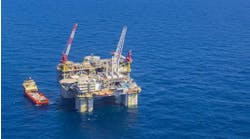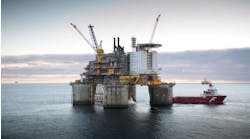Pam Boschee, International Editor
Eni blew all competitors out of the deep water with its bid of $902 million and an offer to pay a signature bonus of $150 million for the relinquished portion of Angola’s block 15 at Sonangol’s recent offshore lease sale. Already a player in the block’s Kizomba area, Eni intends to expand its presence, and it’s willing to pay for it.
Other bids, seemingly small in comparison, were: Sinopec, $750 million; Total, $560 million; Petrobras, $265 million; and Statoil, $254 million.
Sonangol conducted a public opening of sealed tenders for five offshore blocks - 1, 5, 6, 26, and the relinquished portion of block 15. Each block attracted proposals. The opening of the tenders was held in Luanda on April 3 and was the first public opening ceremony in the oil sector in Angola since its independence in 1975.
A total of 20 companies submitted proposals for participation in the blocks. All blocks drew higher signature bonus figures than seen elsewhere in recent years.
The portion of block 15, located 370 km northwest of Luanda, was relinquished by ExxonMobil. Sonangol says proven reserves are estimated at over 3.5 Bbbl and 1.2 Bbbl of remaining potential.
Eni bulks up E&P
Eni’s bidding power springs from its record profits in 2005 of $10.6 billion. The company has targeted its hydrocarbon production to exceed 2 MMboe/d by 2009, with 4% average annual growth from 2005 to 2009. It aims to achieve this via its interests in North and West Africa and the Caspian region.
The company plans to spend $42.6 billion in 2006-2009, two-thirds of which will be devoted to E&P.
The company scored success in its offshore Angola exploration activities in 2005, including:
- Block 0, former Cabinda (Eni’s interest 9.8%), with the NFW 70-5X well that found hydrocarbons at a depth of 2,335 m and yielded 2,000 b/d of oil and natural gas in test production
- Block 14K/A-IMI (Eni’s share 10%) with the drilling of the Lianzi-2ST and Lianzi-2OH appraisal wells on the Lianzi discovery, which showed the presence of natural gas and oil layers at a depth of more than 3,000 m
- Block 15 (Eni’s interest 20%) with the Batuque-3 appraisal well on the Batuque discovery, which confirmed the presence of hydrocarbons at a depth of about 2,000 m. Between January and May 2005 in area B of block 0 (Eni’s interest 9.8%), off Cabinda production started at the oil, condensate. and LPG offshore fields North Sanha and Bomboco. LPG is produced through an FPSO, which the company says is the largest of its class in the world
- At Sanha, a complex for the reinjection of gas into the fields has been built aiming at reducing gas flaring by 50%. Peak production of oil, condensates, and LPG is expected at 100,000 b/d (10,000 b/d net to Eni) in 2007
- Development is in progress of the Benguela, Belize, Lobito, and Tomboco oil fields at a depth between 300 and 500 m in block 14 (Eni’s interest 20%). The project provides for the drilling of 50 wells and the installation of a compliant tower with production facilities for Benguela/Belize. The first oil was produced in January
- Lobito and Tomboco will be developed by means of underwater completion and will be connected to the compliant tower of Benguela/Belize with start-up scheduled in the second half of 2006. Peak production from the four fields is expected in 2008 at 188,000 b/d (32,000 net to Eni)
- In July, as part of Phase B of the development of discoveries in the Kizomba offshore area in block 15 (Eni’s interest 20%) the Kissanje and Dikanza fields were started up five months ahead of schedule at a water depth between 1,000 and 1,300 m. The project provides for the drilling of 58 wells (34 producing and 24 injection), the installation of a tension leg platform for Kissanje, and an underwater production system for Dikanza. Production will be treated at an FPSO common to both fields with a capacity of 250,000 b/d and a storage capacity of over 2 MMbbl. Production peaked at 47,000 b/d net to Eni at year end 2005.
Deadline extended
Sonangol extended the submission deadline for proposals (originally March 31) on two out of seven offshore oil blocks offered in its latest licensing round.
Proposals for blocks 17 and 18, located in the deeper waters of the lower Congo Basin, may now be submitted by May 8.
The extension came as Sonangol decided to separate the development of blocks 17 and 18 from the construction of an onshore refinery in Angola.
When the bid round was launched in December 2005, Sonangol intended for producers interested in these blocks to also undertake the SONAREF refinery project, but the company is currently in negotiations with another party interested in building the refinery.
No takers for Nigeria and Sao Tomé and Principe JDZ blocks
In contrast to Angola’s contested block 15, Nigeria and Sao Tomé and Principe instead have withdrawn from auction the last three of nine offshore oil exploration blocks in their Joint Development Zone due to lack of interest by oil firms.
The head of the island state’s National Petroleum Agency, Luis dos Prazeres, blamed the lack of bidding on the fact that they are located in deep waters where it is more difficult and expensive to prospect for oil.
The three blocks will most likely go up for auction again in six or seven years when exploration is already under way in the six other blocks in the JDZ, he says.
Sao Tomé plans to launch tenders for offshore oil exploration in its Exclusive Economic Zone by the middle of next year after parliament approves new legislation regulating activity in the area.
The government is already at work on legislation covering environmental issues, customs duties, and foreign exchange issues, which could be approved by parliament by the end of this year.
Oil deposits detected in the waters off Sao Tomé since 1995 have piqued international interest; some studies suggest the islands sit on between 6-11 Bbbl of oil.
In January, a consortium comprising ChevronTexaco, ExxonMobil, and Nigeria’s Dangote Equity Energy Resources began drilling the first well in the JDZ, located 200 km (120 mi) south of the Niger Delta.
The well, being drilled in deep waters in block 1 of the JDZ, is seen as a crucial first indicator of whether the area does contain large and potentially profitable oil and gas reserves.


